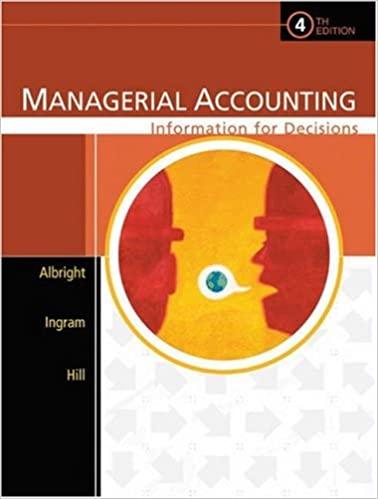1. Which of the following represents the correct order in which the budget documents for a manufacturing...
Question:
1. Which of the following represents the correct order in which the budget documents for a manufacturing company would be prepared?
a. Sales budget, cash budget, direct materials budget, direct labor budget
b. Production budget, sales budget, direct materials budget, direct labor budget
c. Sales budget, cash budget, production budget, direct materials budget
d. Sales budget, production budget, direct labor budget, cash budget, pro forma financial statements 2. Which of the following is not included as one of the four major sections of the cash budget?
a. The receipts section
b. The financing section
c. The selling and administrative expense section
d. The cash excess or deficiency section 3. A major advantage of budgeting is that it:
a. eliminates major uncertainties associated with the business environment.
b. ensures that management's objectives will be met.
c. requires managers to give priority to the planning process.
d. eliminates the need for stringent controls.
4. Which of the following is not correct with respect to the manufacturing overhead budget?
a. The manufacturing overhead budget includes selling and administrative expenses.
b. Manufacturing overhead can be broken down by cost behavior.
c. The manufacturing overhead budget should include all costs of production other than direct materials and direct labor.
d. The budgeted variable cost of manufacturing overhead is dependent on the number of units to be produced, as shown in the production budget.
5. Budgeted production needs are computed by:
a. adding budgeted sales to the desired ending inventory and deducting the beginning inventory.
b. adding budgeted sales to beginning inventory and deducting the desired ending inventory.
c. adding budgeted sales to the desired ending inventory.
d. deducting beginning inventory from budgeted sales.
6. Which of the following is not true with respect to a participative budgeting process?
a. Participative budgeting requires less managerial involvement.
b. Participative budgeting motivates managers by involving them in the budget process.
c. Participative budgeting requires greater coordination between departments and disciplines.
d. Participative budgeting relies on a bottom-up approach.
7. The materials purchases budget is prepared using which format?
a. Beginning inventory + units to be produced - ending inventory
b. Raw material required for production + desired ending raw materials inventory beginning raw materials inventory
c. Ending inventory + beginning inventory - units to be produced
d. None of the above is correct.
8. The cash budget is comprised of all the following except:
a. cash receipts.
b. cash disbursements.
c. accrued sales revenue.
d. proceeds from loans and loan repayments.
9. A collection of related operating budgets is known as a:
a. pro forma financial statement.
b. flexible budget.
c. static budget.
d. master budget.
10. Budgeting in service companies:
a. can be more difficult than in manufacturing companies because of complexities involved in tracing costs to a particular service.
b. typically does not involve materials purchases.
c. can help managers understand the cost of providing services.
d. All of the above are correct.
Step by Step Answer:

Managerial Accounting Information For Decisions
ISBN: 9780324222432
4th Edition
Authors: Thomas L. Albright , Robert W. Ingram, John S. Hill





